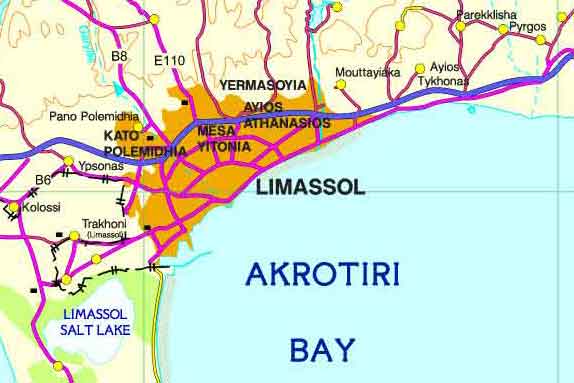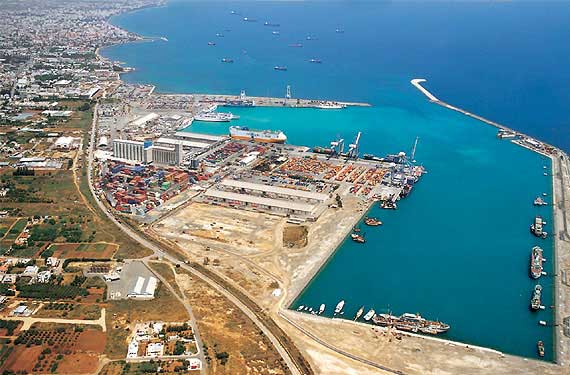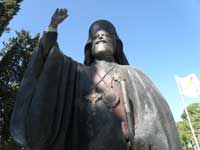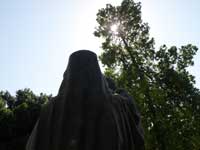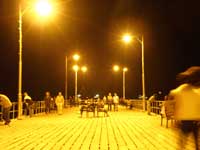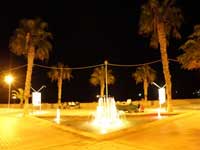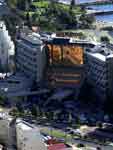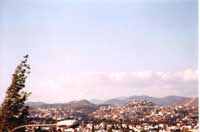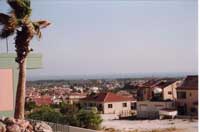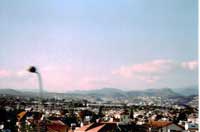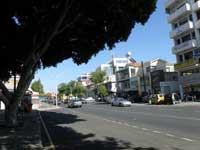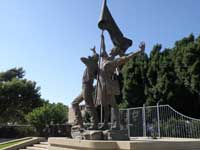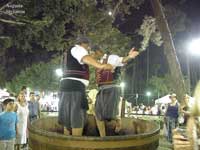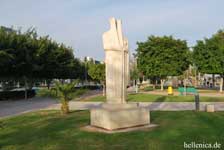Limassol |
|
|
Limassol, Google Earth
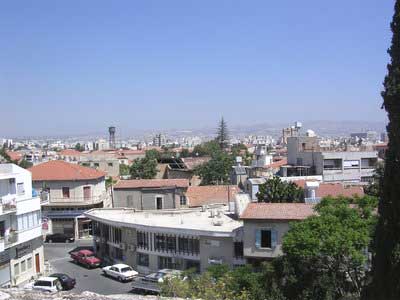
View of Limassol from the top of the medieval castle museum [Source]
Limassol (Greek: Λεμεσός, Lemesos; Turkish: Leymosun) is the second-largest city of Cyprus, with a population of 161,000 (2001 census), and the biggest municipality of the island. The city is located on Akrotiri Bay, on the island's southern coast.
It has experienced great development after the tragic events occurred by the Turkish invasion in 1974, becoming the biggest port in the Mediterranean transit trade. Limassol has since then become one of the most important tourism, trade and service-providing centre in the area. Limassol is renowned for its long cultural tradition. A wide spectrum of activities and a great number of museums and archaeological sites are proposed to the interested visitor.
Limassol was built between two ancient cities, Amathus and Kourion, so during Byzantine rule it was known as Neapolis (new town). Limassol's tourist strip now runs east along the coast as far as Amathus. To the west of the city is the Akrotiri Sovereign Base Area of the United Kingdom.
Limassol also attracts a wide range of tourists mostly during the summer season to be accommodated in its several luxurious hotels and apartments.
Spyros Kyprianou, the former president of Cyprus was from Limassol. Marcos Baghdatis, an internationally famous tennis player, is from Limassol.
History
The town of Limassol is situated between the ancient towns of Amathus and Curium (Kourion). The English King Richard the Lionheart destroyed Amathus in 1191. Lemesos (Limassol) was probably built after Amathus had been ruined. However, the town of Lemesos (Limassol) was inhabited since the very old times. Graves that were found there date back to 2.000 B.C. and others date back to the 8th and 4th century BC. These few remains that were left behind show that a small colonization must have existed which did not manage to develop and flourish.
The ancient writers mention nothing about the foundation of the town.
According to the Synod which took place in 451, the bishop of Theodossiani Sotir as well as the bishops of Amathus and Arsinoe were involved in the foundation. Theodossiani is regarded the same as Limassol was known later as Neapolis. Bishop Leontios of Neapolis was an important church writer in the 7th century.The records of the 7th Synod (787) refer to it as the bishop’s see. The town was known as Nemesos in the 10th century. Constantine Porfyrogennitos refers to the town by this name.
The history of Limassol is largely known by the events of 1191 A.D. that put an end to the Byzantine dominion of Cyprus. The king of England, Richard the Lionheart, was travelling to the Holy Land in 1191. His fiancιe Berengaria and his sister loanna, (Queen of Sicily), were also travelling on a different ship. Because of a storm, the ship with the queens arrived in Lemesos (Limassol). Isaac Comnenus, the Byzantine governor of Cyprus, was heartless and cruel, and hated the Latins very much. He did not allow the queens to get off the ship and did not even help them. When Richard arrived in Lemesos (Limassol) and met Isaac Comnenus, he asked him to contribute to the crusade for the liberation of the Holy Land. While at the beginning Isaac had accepted, he later on refused to give any help.
Richard then chased him and beat him. Cyprus was therefore taken over by the British. Richard celebrated his marriage with Berengaria who had received the crown as queen of England in Cyprus. So, the Byzantine dominion in Cyprus came to an end.Richard destroyed Amathus and the inhabitants were transferred to Limassol.
A year later, in 1192 A.D. Cyprus was sold to the Templars, rich monks and soldiers whose aim was the protection of the Holy Sepulchre in Jerusalem. The knights enforced high taxes, in order to put back the money that had been given for the purchase of Cyprus. This led to the revolt of the Cypriots. They demanded that they should get rid of the bond of the promise. Richard accepted their request and a new purchaser was found: Guy de Lusignan, a Frank, a Roman Catholic. Cyprus was thus handed over to the Frankish Dynasty of the Lusignan kings of the medieval Cypriot kingdom.
For a period of about three centuries 1192-1489, Limassol enjoyed a remarkable prosperity. Cyprus was characterized by its great number of Latin bishops. This lasted until the occupation of Cyprus by the Turks in 1570 A.D. Latin battalions which established monasteries were settled down there.
The settling down of merchants in Cyprus and particularly in Limassol in the 13th century led to the financial welfare of its inhabitants. Its harbor as a center of transportation and commerce, contributed greatly to the financial and cultural development.
The King of Germany, Frederick II, urged by the Templars of Cyprus who were enemies of Ibelen, arrived in Limassol and took over in the town in 1228. He then called John Ibelen to come before him, in order to discuss the plans against the Muslims. John Ibelen came before him accompanied by the under-aged King Eric and all the Templars of Cyprus. When Ibelen refused to cooperate, Frederick had no choice but to let him go. The German King took over in Limassol and in other towns. He appointed his own governors but he finally left Cyprus. The forces of Frederick were finally beaten in the battle of 1229, which took place in Agirta, a village in the Kyrenia area, between the forces of Frederick and the troops of the Franks, which were led by John Ibelen. The outcome of the battle meant the beginning of the freedom of Cyprus from the Germans.
Limassol witnessed the attacks of the Mamelukes of Egypt. The harbor of Limassol had become a refuge for the pirates who were ravaging the countries of the Eastern Mediterranean and were stealing the products of the Mohammedans. The lords were getting richer and richer because of the money that was given to them for their assistance to the pirates. Thus, a military force arrived in Limassol in 1424, sent by the Mamelukes of Egypt. The Mamelukes devastated and burned Lemesos (Limassol). A year later, they invaded Cyprus again, this time with greater forces. They plundered Famagusta and Larnaca, and then arrived in Limassol where without any difficulty they occupied the Castle, burned many places, plundered others and then returned to Cairo. The Mamelukes caused even greater destruction in Limassol and other places in 1426. Janus, the king of Cyprus, was defeated by them in Chirokitia and was sent back to Cairo as a prisoner.
Cyprus was sold in 1489 A.D. to the town of Venice by the Cypriot Queen Catherine Cornaro. The Venetians were not interested in Cyprus. They were only interested in receiving the taxes and in exploiting the country’s sources. They destroyed the Castle of Limassol. Travelers who visited Cyprus in the 16th century commented on the poor condition of the local population in the towns of Cyprus.
All the inhabitants of Cyprus were enslaved by the Venetians, and were obliged to pay a tribute of 1/3 of their income, whether this was part of their products of the land, e.g. wheat, wine, oil, or animals or of any other product.
The Turks invaded Cyprus in 1570-1571 and occupied it. Limassol was conquered in July 1570 without any resistance. The Turks devastated and burned it. Descriptions of different visitors inform us that the town of Limassol looked like a village with a considerable number of inhabitants. The Christians used to live in small houses of such low height, that one had to bend in order to enter the house. This was deliberately chosen in order to prevent the Turks from riding a horse, to enter the houses.
During the years of the Turkish domination, Cyprus faced a general decline. The Turks did not contribute to any development. Greeks and Turks used to live in distinct neighborhoods. During the years of the Turkish domination, the intellectual standard of the Cypriots had declined. The lack of interest on the part of conquerors, the oppression and the high taxation were restraining factors for the intellectual development of the children. The church played an important role in the education of the country during the years 1754-1821. During those years new schools were set up in all the towns. Greek intellectuals used to teach Greek history, Turkish and French. The following schools operated in the town of Limassol:
The Greek School which was established in 1819.
The first public school which was established in 1841.
The Girls’ School which was established in 1861.
The British took over in Cyprus in 1878. The first British governor of Limassol was Colonel Warren. He showed a particular interest in Limassol and even from the very first days the condition of the town showed an improvement. The roads were cleaned, the animals were removed from the center, roads were fixed, trees were planted and docks were constructed for the loading and unloading of those ships that were embarked away from the shore. Lanterns for the lighting of the central areas were also installed in the 1880. In 1912, electricity finally replaced the old lanterns.
From the very first years of the British occupation, a post office, a telegraph office and a hospital began to operate. In 1880 the first printing press started working. It was in this printing press that the newspapers «Alithia» and «Anagennisis» were published in 1897. The newspaper «Salpinx» was published at the same time.
At the end of the 19th century the very first hotels began to operate. Among these were «Europe» and «Amathus».
These changes that the British brought about contributed to the development of an intellectual and artistic life. Schools, theaters, clubs, art galleries, music halls, sport societies, football clubs etc. were all set up and meant a great deal to the cultural life of Lemesos (Limassol).
Job opportunities concerned the wine and ceramic industries, as well as the commerce and tourism developed by the port.
Administration
The first marxist groups in Cyprus formed in Limassol in the early 1920s. In 1926 the Communist party of Cyprus was formed in the city. Its successor AKEL dominated municipal elections, since the first free elections in 1943 won by Ploutis Servas.
The current Mayor of the municipality is Demetris Kontidis - AKEL member as well - and he was elected Mayor of Limassol in December 1996 to serve a five year term and for the second time to serve a five year term for the period of 2002 – 2006. Since May 10th, 2004 he has been elected President of the Union of Cyprus Municipalities.
Economy
The development of tourism in Limassol began after 1974 when the Turks invaders occupied Famagusta and Kyrenia, the basic tourist areas of Cyprus. Limassol has some very good beaches, rich in sand and suitable for sunbathing and swimming. A bathing beach with all the necessary facilities, provided by the «Cyprus Organization of Tourism» (COT), is operating in the town of Limassol, in «Dasoudi» area.
Limassol became the major sea port of the Republic of Cyprus in 1974. Before 1974, that role had been filled by Famagusta which is now located in the Turkish controlled part of the island).
Limmasol is the base for many of the island's wine companies, serving the wine-growing regions on the southern slopes of the Troodos Mountains (of which the most famous is Commandaria). The most important ones are KEO, LOEL, SODAP and ETKO. The wines and cognacs (brandies) that are produced by the grapes that grow in the countryside, are of excellent quality. They have won several awards in international exhibitions. There is a considerable consumption of wine products in Cyprus by the locals and the foreign visitors. Big quantities are exported to Europe. The KEO factory also produces an excellent kind of beer. The town of Limassol is the biggest industrial center of the province. There are about 350 industrial units with 90 industry wares. These industries concern dressmaking, furniture, shoes, drinks, food, prints, metal industry, electric devices, plastic wares as well as many other different industries.
Limassol is an important trade center of Cyprus. This is due to the presence of the British bases at Episkopi and Akrotiri, and to the displacement of the population in Limassol after the Turkish invasion in 1974. The trade markets are gathered in the center of the town and in the tourist area along the coast that begins from the old harbor and ends in Amathus area. Most of the hotels, restaurants, confectioneries, discos and places of entertainment in general, are to be found in this area.
Limassol has two ports. The old port and the new port. The new port has the greatest commercial and passenger flow of traffic and it is the biggest port in the free part of Cyprus. The old harbor has a breakwater 250 meters long and it is able to receive only three small ships. It is thus normally used by small fishing boats. The new harbor is 11 meters deep and has break-waters that are 1.300 meters long. This one is able to receive about 10 ships depending on their size. Exports of grapes, wines, carobs, citrus fruits and imports of cereals, vehicles, machines, textiles, agricultural medicines, fertilizers, iron etc. are exported and imported through these ports.
Demographics
Internal migration since the 1960s and influx of displaced persons after 1974 significantly increased the population of Limassol and its suburbs. Greater Limassol today includes the municipality of Limassol (includes the suburb of Agia Fyla) and the municipalities of Polemidhia, Mesa Geitonia, Agios Athanasios and Germasogeia.
Limassol traditionally had a mixed population of Greek and Turkish Cypriots. The majority of Turkish Cypriots moved to the north in 1974. Accordingly, many Greek Cypriots who became refugees after they had fled from the north of Cyprus settled down in Limassol. During the 1990s several Cypriot Roma (people) (considered Turkish Cypriots according to the constitution) returned from the North of the island to the Turkish quarter of Limassol.
The rise of the population birth rate during the late 19th and 20th c. (1878-1960) was 70%. The number of inhabitants was 6.131 in 1881, while in 1960 the number had risen to 43.593. The number of the Greek population was estimated at 37.478, while the Turkish population at 6.115.
Sites of interest
The medieval castle is one of the nine castles of Cyprus (the others are at Kolossi, Larnaca and Paphos now in the Republic of Cyprus controlled area, and Famagusta, Kantara, Buffavento, St. Hilarion and Kyrenia now within the de facto but internationally unrecognised state of the Turkish Republic of Northern Cyprus). It was built by the Byzantines around l000 AD. Around the same period, a chapel was also built there. Richard the Lionheart is supposed to have married his fiancée Princess Berengaria of Navarre on this site after her ship was grounded nearby in 1191 as she accompanied him to the Third Crusade, on his way to Holy Land. The Castle was used as a prison, between 1790-1940
The medieval castle of Limassol now serves as a medieval museum. The collection that the museum provides covers the era of 400 - 1870 A.D. A visitor can see numerous exhibits: cannons, wood carvings of the 17th and 18th century, paintings and tombstones, statues, suits of armor, coins, terracotta, metalware and pottery, glass and marble articrafts.
The Archaeological Museum provides a very interesting collection of antiquities found in the district of Limassol, dating from the Neolithic Age to the Roman period. Some of the archaeological discoveries are: Stone axes of the Neolithic and Chalcolithic period, potteries and objects of the ancient cities of Curium and Amathus, as well as roman terra cottas, gold jewelery, coins, sculptures, columns, vases, earrings, rings, necklaces, marble statues etc.
The Folk Art Museum is beautifully preserved old house which provides a very interesting collection of Cypriot Folk Art of the last two centuries. Some of the most fascinating objects of the collection are: national costumes, tapestry, embroidery, wooden chests, waistcoats, men’s jackets, necklaces, a variety of light clothes, town costumes, country tools etc. The museum was established in 1985. More than 500 exhibits are housed in its six rooms. The museum was awarded the Europa Nostra prize, in 1989. Here, the visitor can study Cypriot culture through the hand-made exhibits.
Public Garden is situated on the coastal road. It provides a great variety of vegetation: eucalyptus trees, pine trees and cypresses. In this beautiful environment the citizens of Limassol and many visitors can walk around and enjoy themselves. Inside the garden, there is a small zoo. There, the visitor can see deer, moufflons, ostriches, pheasants, tigers, lions, monkeys, vultures, pelicans and other animals and different kinds of birds.Not far from the zoo there is the small natural history museum and the garden theatre that is reconstructed to host famous international groups.
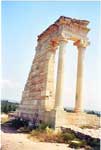
Apollon Hylates Sanctuary in Kourion
Festivals
Limassol is famous in Cyprus for its festivals, like the Carnival and Wine Festival.
The Limassol Carnival festival lasts for ten (10) days, with jolly and amusing masquerading. This custom is very old, going back to pagan rituals. With the passage of time it has acquired a different, purely entertaining character, with a large, popular following. The festival starts with the entrance parade of the King Carnival, followed by a fancy-dress competition for children. During the Carnival parade in the main streets, large crowds from all over the island gather to watch the floats with the serenade and other masqueraded groups. Many fancy-dress balls and parties take place at many hotels every night.
During the first quarter of September, the great Wine Festival of Cyprus takes place in the Municipal Garden of Lemesos (Limassol), every evening between 8.00 hrs - 23.00 hrs. During the festival the visitor has the chance to taste some of the best Cyprus wines, which are offered free of charge. On some evenings, various groups from Cyprus and abroad perform folk dancing and there are also choirs and others.
Other festivals are Flower Festival (May), Festival of the Flood (June), Shakespearean nights and Ancient Greek Drama Festival.
Sports
Apollon Limassol and AEL FC are the two major sport clubs in Limassol, which have football,basketball and volleyball teams. AEL has the records of the most trophies in totally all the sports together. In basketball, Apollon and AEL are very powerfull teams. AEL dominates the Cypriot basketball, while it has the record of the most time champions. They were the Cyprus Champions for three concecutive years (the last three years). In football, both teams Apollon and AEL play in First Division. Aris Limassol is another football team which plays in Second Division. AEL women volleyball teams is the permanent champion of Cyprus. There are also teams in athletics, bowling, cycling and other sports.
The football stadium of Limassol is Tsirio, with capacity of 16 000, which hosts the tree football teams of Limassol and in the past it hosted Cyprus national football team. It was used also for athletics. There are various other stadiums for other sports in Limassol. The Apollon Limassol basketball stadium, hosted the 2003 FIBA Europe South Regional Challenge Cup Final Four. The two basketball teams of Limassol participated and AEL became the first Cypriot sport team to win a European Trophy.
Persons
- Markos Kyprianou (Spyros Kyprianou's son) is a Cypriot politician, currently serving as European Commissioner for Health and Consumer Protection.
- Spyros Kyprianou, the former president of Cyprus (1977-1988)
- Marcos Baghdatis, an internationally famous tennis player and who was finalist in the 2006 Australian Open
- Michael Cacoyannis, a filmmaker
- Ploutis Servas
- Constantinos Christoforou a cypriot singer.
Twinned Cities
Limassol Salt LakeLimassol Images
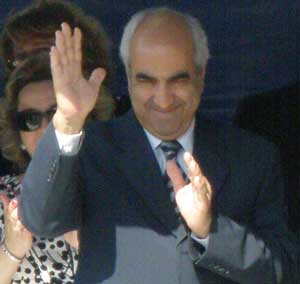
Andreas Christou , Mayor of Limassol, 28 October 2008, "Ochi" Day Celebration
Hotels
Amathus Beach Hotel, Apollonia Beach Hotel, Arsinoe Beach Hotel, Hotel Four Seasons, Golden Arches Hotel, Arsinoe Beach Hotel,
More Images in Limassol Gallery
Reference
Municipality of Limassol - History of Limassol
Links
Images Cyprus, Limassol District
Retrieved from "http://en.wikipedia.org"
All text is available under the terms of the GNU Free Documentation License
|
Ancient Greece |
Medieval Greece / Byzantine Empire |
Modern Greece |
|---|---|---|
|
Science, Technology , Medicine , Warfare |
Science, Technology, Arts |
Cities, Islands, Regions, Fauna/Flora , |

